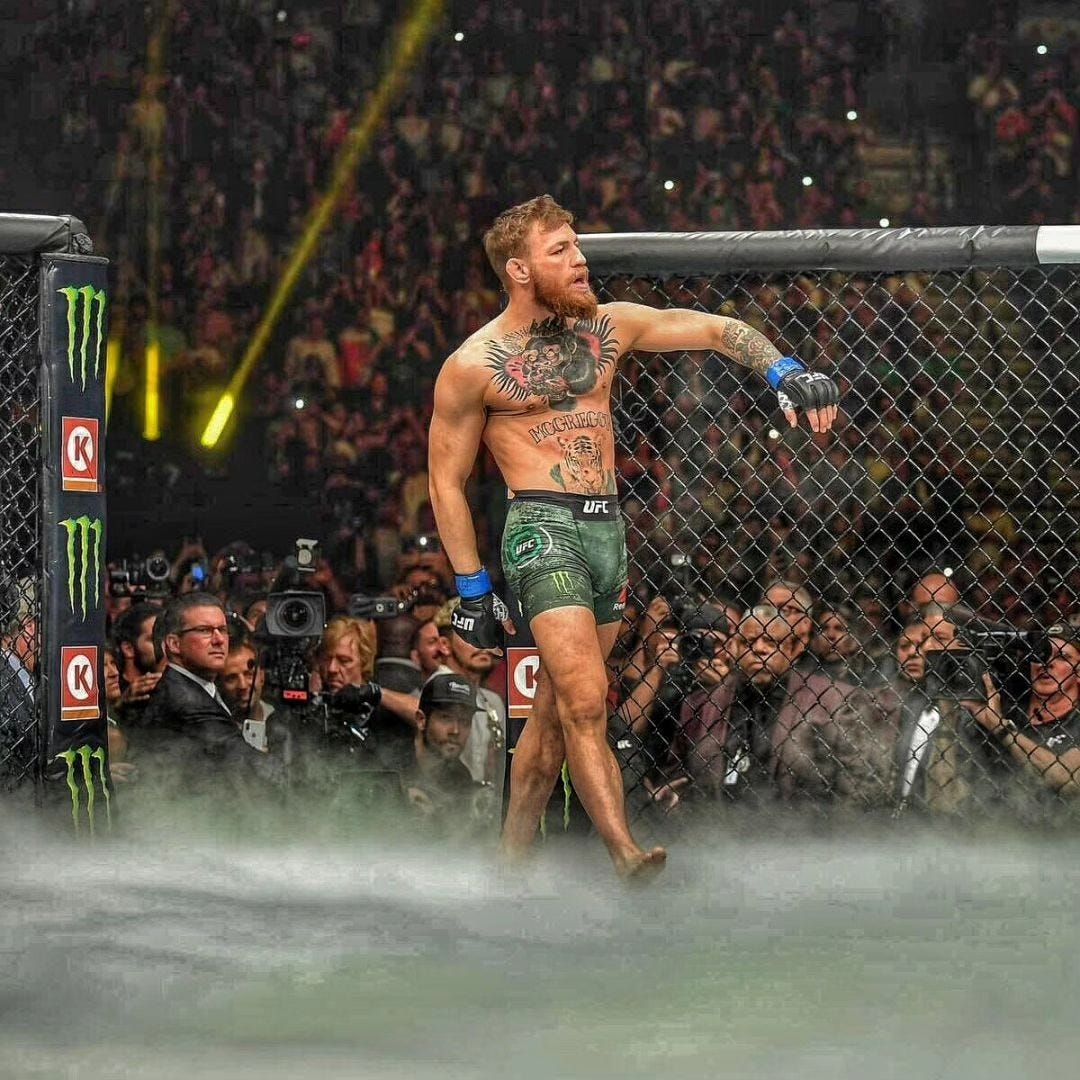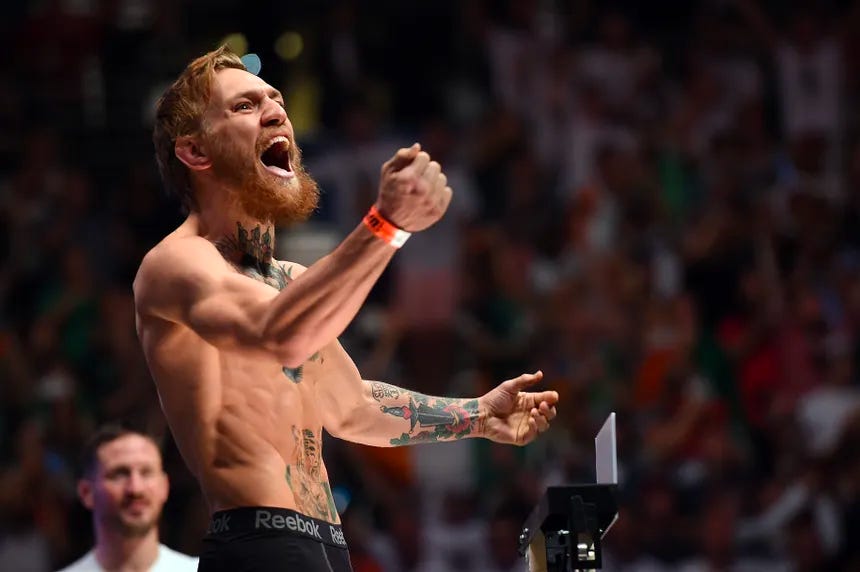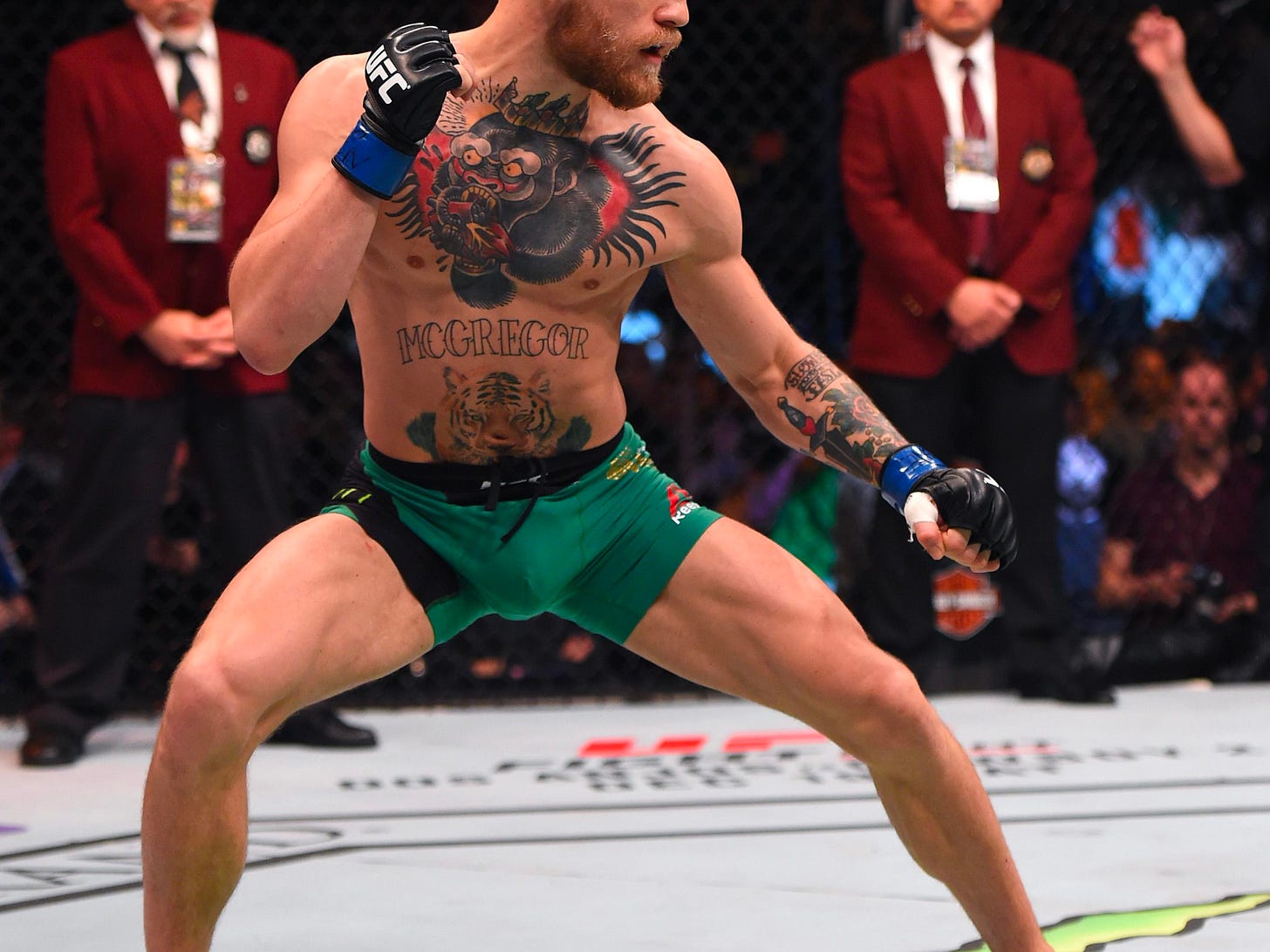An Enigmatic Force
Contents:
Early Career
Mentality
Power
Length
The Stance
Distance Management
Starting a Fight
Kicks Control the Center
Feinting
Coralling Kicks
Punching Past the Black Line
Intercepting Counters
The Greatest Win of All Time
Finishing
The Notorious Conor McGregor. MMA’s brightest star is a polarizing figure who has always provoked the public into following his exploits, for better or worse. McGregor’s career in combat is at an inflection point, few believe the comeback to MMA will materialize.
Recent fans of the sport tend to underrate Conor McGregor because of his latest form and personal woes. Criticisms have surfaced regarding his lack of title defenses and middling competition during his ascent. There is validity to these claims but they do not tell the whole story: many sell him short.
In his prime (2013-2016, Brimage-Alvarez) Conor McGregor was one of the finest fighters to ever exist. He was a genius in the cage and master of traditional southpaw tactics. Before we can understand the strategies that wrought success, we must understand his attributes that lay the foundation of his fighting style.
Disclaimer: The video clips included in this article are not owned by the author. They are included for educational purposes only to illustrate key moments in the fighter’s career and demonstrate aspects of mixed martial arts techniques and strategies. All rights to the video content belong to their respective owners.
Additional Disclaimer: McGregor’s recent legal troubles are nothing to downplay. This article was written before the most recent legal decision, and is not meant to speak on those issues. This is solely an analysis of his fighting style, tactics, and technique.
Early Career
McGregor’s career took off as a young prospect in Cage Warriors, a European feeder league for the UFC. After a humiliating loss to Joseph Duffy in his Cage Warriors debut, McGregor shot through the MMA world like a cannon. He was tailor made for celebrity. His confidence, powerful left hand, and fearlessness made him an enigmatic fighter and more exciting to watch than any other.
Consistently knocking opponents unconscious garnered attention but McGregor’s unshakeable confidence was just as magnetic. Ambition oozed out of his movements whilst in the cage. He looked more comfortable fighting than most do lounging with a book.
McGregor was constantly attempting unorthodox techniques. An elbow TKO on an opponent attempting to take him down (V1), spinning kicks into takedowns (V2), and a firm belief that he could finish anyone with his left hand (V3). He was cocky, but it materialized as a playful fighting demeanor. He showed zero fear that their offense would affect him in any way. He knew that no matter what he tried, no matter how crazy it might seem, it would result in his victory.
V1: McGregor’s opportunism was as present in his early fights as it was in his later life. Creative and violent. Continuous elbows to the dome of a single-leg that should have been released, until his opponent slides into unconsciousness.
V2: McGregor had an unparalleled ease and flow of movement even before his UFC tenure. He was completely unafraid to attempt unorthodox techniques and was rarely punished for his bravery. McGregor feints his lead hand to back the man up, and proceeds to land a spinning head kick. McGregor throws a spinning hook kick as they retreat out to the side, and times a double leg as the opponent over extends on his punches.
V2: McGregor forged his fame through pressure and a left hand. McGregor throws a left straight to back his opponent towards the cage. Trapped, he feints his lead as if to punch and knees through the center of his opponent’s guard. McGregor allows the opponent to press, and the moment they throw their rear hand he dips out to throw his own over the top.
Mentality
McGregor’s path to the UFC could not have been clearer after becoming a two-weight champion in Cage Warriors. Despite the stiffer competition McGregor’s aura did not dwindle. Some men crumble under the pressure when their strategy begins to unravel, when their opponent resists more than anticipated. He lacked such anxiety (V4). His opponents were bound to have moments of success, it is inevitable in a fist-fight. He acted as though the opponent could do nothing to phase him (V5). McGregor fostered an unmatched conviction in his victory and was not afraid to have fun while doing so (V6).
V4: McGregor gets dropped with a leg kick but he does not lose composure. He maintains the center of the octagon, continuing to move forward on Siver. He throws a 1-2 that forces Siver to the cage, and McGregor continues his hunt. He successfully evades an overhand left, body kick, and straight right after landing his own.
V5: McGregor quickly moves forward with his hands raised high, completely disregarding any offense from the opponent. This is enough of an intimidation tactic that was able to back his opponent up to the cage. McGregor unloads with a flurry of punches that force the opponent to shell up. McGregor takes advantage of their broken posture by throwing endless knees to the opponent’s head until he is forced to shoot a takedown out of desperation.
V6: McGregor’s confidence on full display against Dennis Siver. McGregor approaches Siver with his hands down, throwing a high kick followed by a front kick that are threatening enough to put Siver on the back foot. McGregor feels as though he is in complete control, and utilizes some stylish head movement and uppercut feints to jump into a strong head kick. Though Siver blocks the head kicks, they keep his hands defending rather than attacking.
Conor McGregor’s boundless confidence was only half of the foundation that underpinned his style. His physical gifts composed the other. He has flirted with lightweight, welterweight, and everything in between since his loss to Nate Diaz, but it was at featherweight where he was truly able to shine. He might have looked like Skeletor on the scale (I1), but this never affected his in-ring performances.
I1: McGregor at featherweight
Power
McGregor’s punching power was a gift from God, creating some of the most iconic moments in UFC history (V40). He would choose to lightly kick the opponent’s lead leg to keep them occupied at kicking range, but his left straight, rear high kick, spinning hook kick, and front kick to the body were all meant to do damage and instill trepidation. He was rarely interested in throwing non-committal punches and then surprising his opponents with a power shot. He opted to feint and pressure, take note of his opponents reactions, and land full power punches that would lead to a finish. Even against those with legendary chins, McGregor’s power was enough to change their behavior (V7). Holloway was fiercely attempting to stay on the front foot despite McGregor’s pressure throughout the bout. Once McGregor hit him with a hard left straight, Holloway’s demeanor completely shifted. He hesitated, stopping in place to throw non-committal jabs. McGregor picked up on this immediately and pressed forward with a flying knee into an elbow frame. Even though the shot didn’t cause Holloway to wobble, his shift in behavior was evidence of McGregor’s power at play.
V7: McGregor keeps an outstretched hand to pull Holloway’s lead hand down, and stuns him with a rear left hand on the forehead. McGregor takes note of Holloway’s hesitancy following the shot and throws a flying knee into an elbow frame as Holloway is forced to the cage. When McGregor sees an opening for the finish he seizes it.
Punching power is often a nebulous idea that most think is purely genetic. While there is truth to this, this does not mean it can’t be developed and enhanced. A well-publicized portion of McGregor’s training during this time was under the tutelage of Ido Portal. Say what you will about his focus on bodyweight movements and capoeira stylings, McGregor’s comfort and fluidity of movement were no doubt influenced by his training. McGregor’s hip turnover and mobility were integral towards enhancing his already spectacular power (V8). He wasn’t a perfect boxer but he developed an understanding of how to use his whole body while punching. He threw his left hand so that his rear hip and shoulder changed positions with the lead. Turning his entire body into punches with such ease provided the power and snap that shut the lights out of whoever stood across from him.
V8: McGregor jabs and feints his left hand, showing an incredibly mobile upper body and hip turnover for his left hand. McGregor continues to paw at Brimage with his lead hand, waiting for him to rush in. Brimage rushes in with a leaping left hook, and McGregor now fully commits to his left, countering Brimage over the top of his wide hook.
Length
McGregor’s had beautiful punching mechanics aided by his long limbs. McGregor was average in height for a featherweight fighter today (5’8) but towered over most of his opponents (V10). His reach / limb length was the star of his range game. McGregor has a positive ape index of 5.0, where his wingspan is 5 inches longer than his body. This accentuated his straight punching power and elite distance management skills. When McGregor would open up with combinations, he could easily frame off the opponent and push them back out of range when they tried to counter (V9). McGregor controlled the range the fight took place but he was not afraid to simply push shorter fighters away to keep them at his preferred distance. His physical gifts at featherweight were abundant, but how did his style maximize their effectiveness?
V9: McGregor utilizes his reach to its fullest. He swings a long rear uppercut that is not punished by Siver, as McGregor simply pushes him back towards the fence to create space. McGregor jabs Siver and leans into a left straight to the body. Siver attempts to counter with hooks, but McGregor simply regains his stance, hits Siver with a lazy left, and leans again to let Siver’s high kick sail past his nose.
V10: McGregor often benefited from a height and reach advantage at featherweight, but this was even starker against Marcus Brimage. Though he enjoyed a traditional southpaw/open-stance matchup, he had little issue in the closed-stance against Brimage compared to his later fights with Poirer. McGregor utilized knees and uppercuts much more in this fight than any other as the shorter Brimage often threw his head forward of his hips in a less tactical way than McGregor. He simply threw so hard that his head was forced forward by his momentum. McGregor would push him away when he tried to retaliate, solidifying the physical discrepancy between them.
The Stance
The stance (I2). McGregor’s stance was uniquely suited to accentuate his physicality and explosivity. He stood side-on to his opponent, with a wide base and outstretched lead hand. This wide base had him heavy on his front foot which allowed him to dart backwards out of range from an opponent’s punches. This puts him heavy on his rear foot, where he can dart back into range with punches of his own (V11). McGregor was a fighter wholly committed to being an overwhelming offensive force. He rarely threw non-committal shots save a jab, and even then his lead hand would rather occupy the space between his and his opponent’s (V12). Lead-hand fighting is such a staple in McGregor’s fights because he is a true southpaw. Other than Poirer and Brimage, who were not the craftiest strikers at the times he faced them at featherweight, McGregor was always fighting in the open stance matchup and built his game around it. The lead hands and feet occupied the same side because of this, and it makes establishing a jab in the open-stance different.
I2: McGregor imitating his stance before a fight
V11: McGregor’s wide, side-on stance gives him a strong base to dart forwards and backwards from. McGregor jumps back from a level change and left-hook from Alvarez, retreating on a slight angle out to his own left. From here, McGregor places himself more in line with Alvarez’s center, where he can jump back into range to land a rear straight.
V12: McGregor hand-fights to get Holloway focused on the upper body, and then attacks low with a side kick to the leg. Holloway retaliates with his own and follows up with a pawing 1-2. McGregor does not rely on his head movement, instead opting to control the range between their feet. Here he shows he is more than competent at evading shots from close range, and doggedly maintains his position in the center of the octagon when his opponent pressures.
McGregor’s right side (his lead side, made more prevalent by his side on stance) was used to feint, poke, and pester. Jumping low-line side kicks, jab feints, and hand fighting. McGregor utilized his lead weapons as way to clear the way for his rear weapons (V13). The lead hand, after occupying the opponent with the hand fight, could swat away the opponent’s. His left straight, uppercut, and rear kicks were only thrown with intent to kill (V14) the open-side.
V13: McGregor crowds Alvarez’s lead hand, and pulls it down in order to land the jab, leaning into it as his signature to exaggerate his reach advantage. Alvarez attempts to return with hooks as his back is up against the fence, but McGregor pushes off Alvarez’s chest before his hook can reach.
V14: McGregor employs a text-book southpaw counter here. McGregor dips outside of the opponent’s jab in the open-stance and shoots his left hand down the middle inside of the jab.
Distance Management
Keep reading with a 7-day free trial
Subscribe to Movement Martials to keep reading this post and get 7 days of free access to the full post archives.





